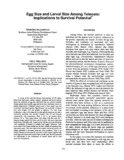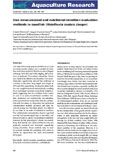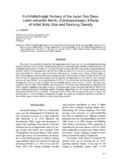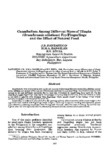Egg size and larval size among teleosts: implications to survival potential
Share
Abstract
A survey of the early life history characteristics of 135 teleost fishes from freshwater, marine, tropical, temperate and boreal habitats show the influence of egg size and larval size on survival potential. Marine species have smaller eggs and larvae than freshwater species at similar temperatures. Coldwater species tend to have larger eggs and larvae than warm water species. Egg diameters are positively correlated with larval lengths (Lh) and weights at hatching. The times from fertilization to onset of feeding (tf), to yolk and oil resorption (ty) and to irreversible starvation (ts), increase linearly with Lh and decrease exponentially with temperature. Both tf and ts are positive linear functions of ty. Thus, larger larvae with much yolk that lasts for a relatively longer period feed later and if not fed, will starve later than small larvae with little yolk. Larger larvae will thus have the advantage under conditions of limited or variable food supply. Moreover, large larvae tend to have large mouths and are thus capable of ingesting large high-calorie prey. They also tend to have higher swimming speeds and greater potential to encounter food and avoid predators. There is no definite relation between growth rates and Lh, but tropical species with small eggs and larvae tend to have high growth rates. Survival potential has implications in the recruitment to natural stocks and in seed production in hatcheries.
Subject
Collections
Related items
Showing items related by title, author, creator and subject.
-
Size measurement and nutritional condition evaluation methods in sandfish (Holothuria scabra Jaeger)
Watanabe, Satoshi; Zarate, Jacques M.; Sumbing, Joemel Gentelizo; Lebata-Ramos, Maria Junemie Hazel; Nievales, Marie Frances (Wiley, 2012)The aims of this study were to establish an accurate size measurement method and a nutritional condition evaluation method of Holothuria scabra (Jaeger). Although 0.5% KCl and 0.05% MgSO4 did not induce anaesthesia, ... -
Illuminated-cage nursery of the Asian sea bass, Lates calcarifer Bloch, (Centropomidae): effects of initial body size and stocking density
Fermin, Armando C. (Asian Fisheries Society; World Aquaculture Society - Southeast Asian Chapter, 2000)This study was conducted to determine the appropriate initial body size and the corresponding stocking density of sea bass, Lates calcarifer, during nursery rearing in illuminated cages. Hatchery-produced sea bass fry of ... -
Cannibalism among different sizes of tilapia (Oreochromis niloticus) fry/fingerlings and the effect of natural food
Pantastico, J. B.; Dangilan, M. M. A.; Eguia, Ruel V. (Department of Fisheries, Bangkok, Thailand; International Center for Living Aquatic Resources Management, Manila, Philippines, 1988)Experiments were conducted in jars, tanks and aquaria to determine the occurrence of cannibalism among 7 different size groups of Nile tilapia (Oreochromis niloticus ) fry and fingerlings. Cannibalism became more intense ...




